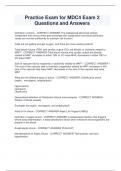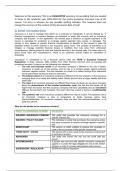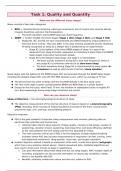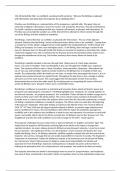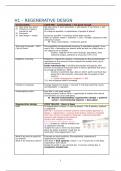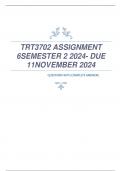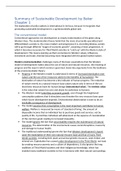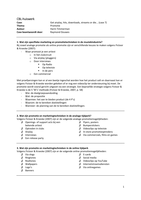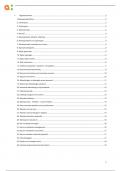Introduction to the field of
organizational behavior
The field of organizational behavior
Organizational behavior: Study of what people think, feel and do in and around
organizations.
Organisations: Groups of people who work interdependently but organized toward some
purpose.
Historical foundations:By late 1940s first course ‘organizational behavior’ → experts in
other fields have been studying organizations for many centuries.
Why study organizational behavior?:
Comprehend and predict workplace events
Adopt more accurate personal theories
Influence organizational events
Organizational behavior is for everyone
Contemporary developments facing organizations
Technological change: Innovations dramatically boost productivity, but also displace
employees and occupational groups that are no longer necessary.
Pro: Information technology gives employees a stronger voice through direct
communication with executives and broader distribution of their opinions to coworkers
and beyond.
Con: Tethering people to their jobs for longer hours, reducing their attentions spans
at work and increasing techno-stress.
Globalization: Economic, social and cultural connectivity with people in other parts of the
world.
Pro: Larger markets, lower costs and greater knowledge and innovation.
Con: Increasing work intensification, reduced job security, poor work-life balance.
Emerging employment relationships: Due to technology and globalization employment
relationships in most countries altered.
Con: 24/7 connected to work due to technology and different time zones due to
globalization.
Work-life balance: Degree to which a person minimizes conflict between work and
nonwork demands.
Telecommuting: Working from home one or more days per month rather than
commute to the office.
o Pro: Better work-life balance, higher productivity and reduced greenhouse gas
emissions.
o Con: Social isolation, less promotional opportunities, less workplace relations,
weaker organizational culture
Workforce diversity: Deep-level diversity is the difference in perceptions and attitudes
about the same situation.
Pro: Different perspectives and information benefit decision making and creativity,
more representative of most communities.
Con: Conflict, problems with communication.
,Anchors of organizational behavior knowledge
Systematic research anchor: States that OB knowledge should be based on systematic
research, consistent with evidence-based management.
Multidisciplinary anchor: States that the field should welcome theories and knowledge from
other disciplines, not just form its own isolated research base.
Contingency anchor: States that OB theories generally need to consider that there will be
different consequence in different situations.
Multiple levels of analysis anchor: States that OB topics may be viewed form the
individual, team and organization level of analysis.
Perspectives of organizational effectiveness
Organizational effectiveness: Describing, understanding and recognizing the four
perspectives on organizational effectiveness.
Open systems perspective: Organizations depend on the external environment for
input, affect that environment through their output, and consist of internal subsystems
that transform inputs to outputs.
o Fit with environment: Input, processes and output align with resources, needs
and expectations of external environment.
Adapt to environment: Configuring internal subsystems to align more
closely within the shifting environment.
Influence environment: Actively trying to influence the environment.
Move to more favorable environment: When can’t adapt or
influence to survive.
o Effective transformation:
Efficiency: Producing more goods or services with less labor,
materials and energy.
Adaptability: Ability to adapt to external environment.
Innovativeness: Designing products and work processes that are
superior to what competitors can offer.
Coordination: Organizations rely on coordinating mechanisms to
maintain the effects.
Organisational learning perspective: Organizational effectiveness depends on the
organization’s capacity to acquire, share, use and store valuable knowledge.
o Intellectual capital: Stock of knowledge.
Human capital: Knowledge, skills and abilities that employees carry
around in their heads.
Structural capital: Knowledge captured and retained in an
organization’s systems and structures -> documents and products.
Relationship capital: Value derived from an organization’s
relationship with customers, suppliers and others.
o Organizational learning processes:
Acquiring: Bringing in knowledge from the external environment as
well as through discovery.
Sharing: Distributing knowledge throughout the organization → formal
and informal communication.
Using: Only an advantage when applied to improve organizational
processes.
Storing: Process of retaining knowledge → organizational memory.
High-performance work practices perspective: Effective organizations incorporate
several workplace practices that leverage the potential of human capital.
o Involvement & autonomy: Motivation, decision making, responsiveness and
adaptability.
, o Competency: Recruitment, selection and training.
o Rewards: Financial and non-financial rewards.
Stakeholder perspective: Offers more specific information and guidance by focusing
on the organization’s relationship with stakeholders.
Internal stakeholders: Employees, managers and owners.
External stakeholders: Customers, suppliers and society.
o Values: Evaluative beliefs that guide a person’s preferences for outcomes or
courses of action in a variety of situations.
o Ethics: Moral principles or values that determine whether actions are right or
wrong and outcomes are good or bad.
o Corporate social responsibility (CSR): Organizational activities intended to
benefit society and the environment beyond the firm’s immediate financial
interests or legal obligations → beyond stockholders and customers →
economic, social and environment.



